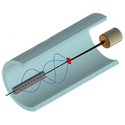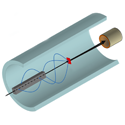Results from HELIOS
Nuclei far from stability present an opportunity to broaden our understanding of nuclear matter. For example, theories that have been developed to explain nuclei near the valley of stability can be tested for nuclei with drastically different ratios of protons to neutrons.
The helical orbit spectrometer, HELIOS, at Argonne National Laboratory in the US is a new device that was designed to study reactions of unstable nuclei with better energy resolution. In a paper appearing in Physical Review Letters, collaborators at Argonne, Michigan State University, and Western Michigan University, all in the US, and the University of Manchester in the UK, present the results of a first test experiment of HELIOS’ capability. They study the classic “stripping” reaction (here, is a deuteron and is a proton) to learn more about the structure of .
Since is an unstable isotope, it cannot function as a target. Instead, is first created as a secondary beam, and the reaction occurs when the beam strikes a target containing deuterons. The use of a heavy projectile and light target is called “inverse kinematics.” The angular momentum of the transferred neutron in the reaction was inferred from the angular distributions of the reaction products detected in HELIOS.
The HELIOS spectrometer can resolve nuclear states apart so that spins and parities could be assigned to the proper levels. The excitation energies and ordering of states do not agree well with shell model predictions, but it is clear that HELIOS is a powerful device for the study of reactions in inverse kinematics, with both short-lived and stable beams. – Gene D. Sprouse





